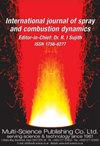RQL燃烧室贫燃区火焰传递函数——对主燃区和混合口速度波动的动态响应
IF 2.1
4区 工程技术
Q3 ENGINEERING, MECHANICAL
International Journal of Spray and Combustion Dynamics
Pub Date : 2023-03-07
DOI:10.1177/17568277231159172
引用次数: 0
摘要
本文对富淬贫燃烧室贫燃区热声火焰传递函数进行了实验研究。贫次生贫化带与富原生贫化带在空间上分离,贫次生贫化带独立进行考察。采用多麦克风法对燃烧室声速对主区和混合口声压的响应进行了表征。然后将贫次区视为连接到2端口Rankine-Hugoniot火焰单元的纯声学3端口网络单元。仅关注由于速度波动引起的热释放波动,前者分别由两个线性叠加的火焰传递函数描述,分别作为来自主区和混合口的速度波动的函数。基于非反应和反应测量,可以从实验数据中提取出两种火焰传递函数。在这项研究中,提出了新的声学方法的火焰传递函数,并将其与化学发光和光电倍增管测量的火焰传递函数进行了比较。研究发现,燃烬区反向扩散火焰在低频范围内与主区速度波动发生反应,并观察到明显的低通行为。混合端口速度波动产生更宽的响应。在本案例中,化学发光法计算的火焰传递函数与声学方法计算的火焰传递函数非常吻合。本文章由计算机程序翻译,如有差异,请以英文原文为准。
Flame Transfer Functions of the Lean Burnout Zone of an RQL Combustion Chamber - Dynamic Response to Primary Zone and Mixing Port Velocity Fluctuations
This article describes an experimental investigation of thermoacoustic flame transfer functions of the lean burnout zone of an rich–quench–lean combustion chamber. With spatial separation of the rich primary from the lean secondary dilution zone, the latter is independently examined. The multi-microphone-method was employed to characterize the combustor acoustic velocity response to acoustic forcing coming from the primary zone and the mixing ports. The lean secondary zone is then treated as a pure acoustic 3-port network element connected to a 2-port Rankine-Hugoniot flame element. Focusing only on heat release fluctuations due to velocity fluctuations, the former are described by two linear superimposed flame transfer functions as a function of the velocity fluctuations coming from the primary zone and the mixing ports, respectively. Based on a non-reacting and a reacting measurement the two flame transfer functions could be extracted from the experimental data. Within this research, flame transfer functions from the new acoustical approach are presented and compared with ones measured using chemiluminescence and a photomultiplier tube. It is found that the inverse diffusion flame in the burnout zone reacts to velocity fluctuations from the primary zone in the low frequency range and a clear low pass behavior is observed. The mixing port velocity fluctuations create a more broadband response. In the presented cases, the flame transfer functions calculated from chemiluminescence match those from the acoustic method very well.
求助全文
通过发布文献求助,成功后即可免费获取论文全文。
去求助
来源期刊

International Journal of Spray and Combustion Dynamics
THERMODYNAMICS-ENGINEERING, MECHANICAL
CiteScore
2.20
自引率
12.50%
发文量
21
审稿时长
>12 weeks
期刊介绍:
International Journal of Spray and Combustion Dynamics is a peer-reviewed open access journal on fundamental and applied research in combustion and spray dynamics. Fundamental topics include advances in understanding unsteady combustion, combustion instability and noise, flame-acoustic interaction and its active and passive control, duct acoustics...
 求助内容:
求助内容: 应助结果提醒方式:
应助结果提醒方式:


